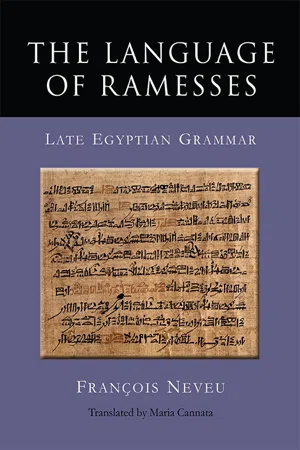
- 282 pages
- English
- ePUB (mobile friendly)
- Available on iOS & Android
About this book
François Neveu's seminal work, here available in English for the first time, enables the reader to explore the Ramesside age through an understanding of Late Egyptian. This phase corresponds to the language spoken from the 17th to the 24th dynasty, which became a written language – used for private letters, administrative, legal and literary texts, as well as some official inscriptions – during the Amarna period (circa 1364 BC). The first part of the book covers the basics of the grammar and morphology, while the second part is devoted to the syntax, covering first the verbal system and then the nominal forms. In addition there are two appendices, one devoted to interrogative constructions and another to syllabic writing. The book incorporates the most recent work on the subject and the clarity with which Neveu presents linguistic and grammatical points, and the hundreds of examples used to illustrate the grammatical presentation, makes this the ideal tool for anyone interested in learning Late Egyptian grammar in order to read and understand texts from this period.The texts also introduce the reader to the daily life of the Deir el-Medina workers, the social movements that shook the community, the conspiracies at court, the embezzlement of some priests and other prominent community figures, major historical events, as well as the stories and novels studied and read by the society of the time.
Frequently asked questions
- Essential is ideal for learners and professionals who enjoy exploring a wide range of subjects. Access the Essential Library with 800,000+ trusted titles and best-sellers across business, personal growth, and the humanities. Includes unlimited reading time and Standard Read Aloud voice.
- Complete: Perfect for advanced learners and researchers needing full, unrestricted access. Unlock 1.4M+ books across hundreds of subjects, including academic and specialized titles. The Complete Plan also includes advanced features like Premium Read Aloud and Research Assistant.
Please note we cannot support devices running on iOS 13 and Android 7 or earlier. Learn more about using the app.
Information



Table of contents
- Cover
- Title Page
- Copyright
- Dedication
- Contents
- Introduction
- Acknowledgments
- Translator’s note
- Bibliographical orientation
- Abbreviations
- Part one: Morphology
- Part two: syntax
- The verbal system
- Independent verbal forms
- Non-independent verbal forms
- Nominal forms
- Part Three: appendices
- List of figures